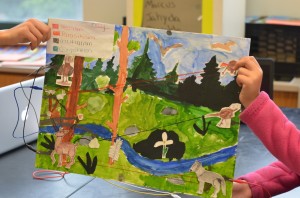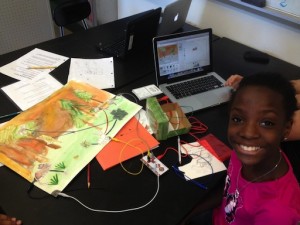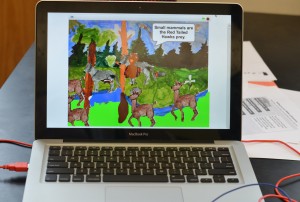Check out the article on the Rindge Avenue Upper School website!!! http://rindgeavenue.cpsd.us/flash/ecomuve_2014
Overview
As part of 6th grade life science and ecology/ecosystems studies, Cambridge Public Schools uses a computerbased virtual environment developed by Harvard called EcoMUVE
(http://ecomuve.gse.harvard.edu/module2.html). Students are presented with a scenario related to a forest ecosystem and utilize the virtual environment in EcoMUVE to come to a solution. From the EcoMUVE website, “students work in teams to visit the two islands over a span of fifty years to see how the populations and forest structure change on each island over time.” This year, 6th grade science teacher Dave Suchy and his students at RAUC expanded upon the EcoMUVE curriculum by collaborating with Ingrid Gustafson, CPS Instructional Technology Specialist and Kyle Browne, director of Cambridge Creativity Commons (cambridgecreativitycommons.org). As a final project articulating a hypothesis and solution to a problem, students created mixed media scientific illustrations depicting the EcoMUVE web of organism interactions. Their paper based ecosystem webs were made into computer based interactive simulations by connecting MaKeyMaKey kits (http://MaKeyMaKey.com/) and were controlled by programming with Scratch (http://scratch.mit.edu/). Students gained practice in 21st century skills such as collaborating and creativity throughout the duration of this project by engaging in STEAM education Science, Technology, Engineering, Art, and Mathematics.
Science
Inspiring students to be engaged in their learning is a challenge for all educators, but it is particularly arduous in middle school. The collaboration between science, arts and technology offers an incredible amount of access points and communication modes, allowing more students to engage with the material. During this project, communication between students was essential to their groups success as students were assigned different roles to research within the team. These roles included a bird watcher, botanist, population specialist, and public health intern. To become an “expert” in their assigned role, students gathered data in EcoMUVE. After discussing a variety of perspectives, data points, observations, and notes from the field guide, students met with their teammates and formulated a claim. Once the claim was developed, students were ready to move on to the art component of the project, learning how to create an ecosystem web as evidence to support the claim.
Art the “A”
Students were introduced to the field of scientific illustration, drawing, and painting techniques for their scientifically accurate 2D food web set in a forest. Included in the illustrations were plants and animals that informed their claim from EcoMUVE. Using photographs as reference tools, students took on the role of scientific illustrators to draw and paint their organisms as accurately as possible. Students arranged a functional, accurate, and aesthetic design of their ecosystem food web by placing organisms appropriately; drawing correct relationship connections for predation, mutualism, parasitism and competition; developing a clear key to accompany their work; and adding graphite lines to link selected organisms to the MaKeyMaKey kit activating the Scratch simulation. Once completed, the forest background and organisms were photographed.
Technology, Engineering, & Math
Building upon computers science skills learned in previous science class projects, students brought their scientific research and artwork to life through programming. Their scientific illustrations were uploaded and shared with students through Google Drive. With the help of Scratch (http://scratch.mit.edu/), students programmed relationships between the organsims in their ecosystem, calculating the number of organsims in specific scenarios thinking about “if/then” statements. Finally, students linked their watercolor drawings to Scratch using MaKeyMaKey, enabling the simulation to be controlled by pressing on individual organisms on the food web. Groups experienced a real life computer science scenario where each member of their group contributed knowledge towards completing one final product. To make the ecosystem come to life, students learned about concepts such as loops, conditionals, operators, and sequencing.
Final Thoughts
While the students were learning and applying science during the entire project, the mode they used to gain and express their knowledge varied throughout. Science writing, science reading, drawing, painting, designing, and computer coding combined with speaking and listening skills helped students express their understandings. Independence pushed students to think critically to solve any problems that may have arisen in their ecosystem and in their working groups. Not only did this project foster student learning, but it also provided a platform for arts, science, and technology educators to collaborate as well as think critically and creatively about best practices. Bringing knowledge from the individual fields of expertise enriched and strengthened the curriculum as well as demonstrated positive leadership and collaboration to all students.


